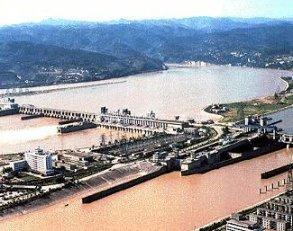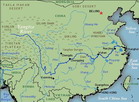2020 Yangtze River Cruise and Ferry Starting from 79 USD p.p.!
Yichang Introduction
Situated at the eastern mouth of the gorges, Yichang is the administrative centre of nine surrounding counties. lts population is engaged in light industry, ch emical and steel production. The construction of the Gezhou Dam helped Yichang to grow from a small town of 30,000 into a city. The Three Gorges Dam is only 44 kilometres (27 miles) upstream Thus although some houses and factories wiII be submerged, a plethora of new buildings has been built higher up, in anticipation of the economic boom in the Yichang administrative region.
emical and steel production. The construction of the Gezhou Dam helped Yichang to grow from a small town of 30,000 into a city. The Three Gorges Dam is only 44 kilometres (27 miles) upstream Thus although some houses and factories wiII be submerged, a plethora of new buildings has been built higher up, in anticipation of the economic boom in the Yichang administrative region.
HISTORY OF YICHANG
History records that as early as 278 BC the town was razed to the ground in a battle between the armies of Chu and Qin. In the Three Kingdoms period 50,000 Wu troops set fire to the encampments of the Shu army, utterly routing Liu Bei,Who retreated upriver to Baidi Cheng.
Yichang became a treaty port in April l877, in accordance with the Chefoo(Yantai) Convention of 1876 signed with Britain and continued to be the furthest inland treaty port for many years, as large merchant and passenger vessels were not yet able to navigate the gorges upstream to Chongqing. Here, cargo was unloaded from the larger boats plying the stretch of river between Yichang and Wuhan, and reloaded onto smaller ones running between Yichang and Chongqing.
An American traveller in 1921 described the port as 'crowded, incessantly busy, a perfect maelstrom of sampans, junks, lighters with cargo, steamers and gunboats.’ Eventually technology enabled ships to continue the journey upstream and Chongqing itself became a treaty port in l89l.The English trader Archibald Little, noting his expenses for a night's stay in the treaty port, showed how far four English pennies went in late l9th-century Yichang and incidentaIly his solicitude for his servant :
Supper for self and coolie, 4 bowls of rice at 1l0 cash (copper cash),
'fixings' of cabbage and bean curd free~~~~~~~~~~~~~~~~~~40
Use of straw-plaited mattress for ditto, 2 at l0~~~~~~~~~~~~~~~~~~~~~~~~~~~ 20
Breakfast, sane as supper~~~~~~~~~~~~~~~~~~~~~~~~~~~~~~~~~~~~~~~~40
Supper and breakfast for 'Nigger', my dog.~~~~~~~~~~~~~~~~~~~~~~~~~~~~~20
Pair of straw sandals for coolie (his old ones being worn out) ~~~~~~~~~~~~~~~~~12
Total 132 copper cash, or, in English money, 4d ~~~~~~~~~~~~~~~~~~~~~~~~ 132
During the warlord years of the early part of this century, Yichang revenue was greatly boosted by taxes imposed on boats carrying homegrown opium from Yunnan and Gui2hou Provinces by its Opium Suppression Bureau. During the war with Japan, the gorges above Yichang again acted as a barrier. When Wuhan fell to the Japanese in l938, Yichang became the centre for shipping essential personnel, machinery, libraries and museum collections up the Yangtze toChongqing. After the Battle of Yichang in 1940 the Japanese capture of Yichang marked their furthest westward advance. The Japanese also used Yichang as a staging area for bombing raids over Chongqing.
WHAT TO SEE IN YlCHANG
The streets of the old town centre are lined with trees. Though the city wall was puIled down in 1929, the street names still indicate where it once stood (Eastern Ring Road, Southern Ring  Road and so on). The main market is found just off Jiefang Lu.Along the waterfront a few old foreign buildings of the treaty port days can be seen.
Road and so on). The main market is found just off Jiefang Lu.Along the waterfront a few old foreign buildings of the treaty port days can be seen.
Apart from the Gezhou Dam , tourists may also visit the Three Travellers' Cave, ten kilometres (six miles) northwest of the city. In 819, three Tang-dynasty poets, Bai Zhuyi, his brother Bai Xingiian and Yuan Zhen, met up in Yichang and made an excursion to this site. While enjoying the spectacular scenery, they inscribed some poems on the cave walls. Afterwards they were dubbed the 'First Three Travellers'. In the Song dynasty (960--1279) the famous literary fami1y of Su--the father and two sons--on their way to the capital to take the imperial examinations, visited the cave and added poems as well. All three passed the imperia1examinations at the same time. People call these gentlemen the 'Second Three Travellers'. Throughout the ages, other visiting Iiterati and officials have left their contributions on the cave walls.
A small spring trickles through the rock near the entrance, local superstition maintains that if women wash their hands in its pure water it will improve their culinary skills. The hill above the cave presents a fine view of the entrance toXiling Gorge :The Zixi Pavilion contains a memorial stone to the 11th-century philosopher Ouyang Xiu, who lived in Yichang for three years. Near-by is a drum platform said to be the site where Zhang Fei (see page 42), a general of the third--century Kingdom of Shu, beat his battle drums.
Visitors are usuaIIy taken on a Short excursion a1ong a mountain road offering stunning views of Xiling Gorge, and passing several peaks, including Filial Mountain and Camel Mountain. The road continues over a natural stone bridge,Whidi was originlly--so legend has it--a fairy's silken sash, thrown up to help her mortal husband ascend to heaven with her. The stone gateway and its steep stone steps delineate the ancient land route crossed by travellers to western Hubei and Sichuan.
Below Yichang lies the bluff known as Tiger's Teeth Gorge which, for travellersupriver, is the first glimpse of sights to come.



